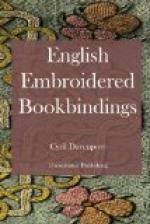A copy of The Way to True Happiness. printed in London in 1639, is bound in white satin, and embroidered with figures of David and a Queen. It is a little larger than the majority of the satin-embroidered books, measuring 7 by 4-1/2 inches, and is, for its time, a very fine specimen. Both figures stand under an archway with columns, all worked heavily in silver cord, guimp, and thread. The columns have ornamental capitals and a spiral running round their shafts, and the upper edge of the arch is ornamented with crockets of a peculiar shape. Within this archway, on the upper cover, is a full-length figure of a Queen, finely worked in split-stitch with coloured silks. She wears a red dress with long, falling sleeves, a purple body and gold collar. On her head is a golden crown, with six points. She carries, in her left hand, a golden sceptre, and has also a golden belt. The outlines are everywhere marked either with a gold or silver twist. On the ground, which is in small hillocks, grow a strawberry and two other small plants; a snail is also shown. Scattered about the field are a ‘skeleton’ caterpillar—at one time probably filled in with peacocks’ feathers,—a conventional lily, a butterfly, and the sun, with rays, just appearing from under a cloud. In the two upper corners are flowers, a pansy and another, and smaller ones down each side.
On the lower board, within the arch, is a figure of David. He wears a short tunic of orange and silver, with vandyked edge, and a short skirt of blue and silver, with a long cloak of cream, pink, and silver, clasped with a silver brooch; on his head he wears a silver crown, with a red cap and green and red feathers; on his feet are brown, high boots. In his left hand is a silver harp of ornamental pattern, and in his right a silver sceptre with a little gold about it. The ground, in hillocks, has a few small flowers growing upon it, and a large tulip is just in front of the King; on the field are also a moth and a snail. At the top is a blue cloud. The upper corners have a red and yellow tulip and a pansy with bud in them, and smaller flowers are worked down each side. The back is very tastefully ornamented with an undulating scroll of gold cord, widening out here and there into conventional leaves of gold guimp in relief. On this scroll are sitting three birds, and there are also a bunch of grapes, a tulip, daffodil, and other flowers with leaves, conventionally treated, all worked in coloured silks.
There are the remains of two red and yellow silk ties on the front edges of each board, and the edges of the leaves are gilded and gauffred. With this book is a canvas bag, simply ornamented with a design worked in red silk.
[Illustration: 47—New Testament. London, 1640.]
New Testament. London, 1640.
The curious little New Testament of 1625, now at Oxford, which I have already described, is perhaps the earliest example left on which needlepoint lace in coloured silks is much employed.




